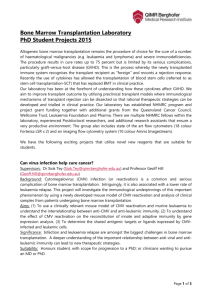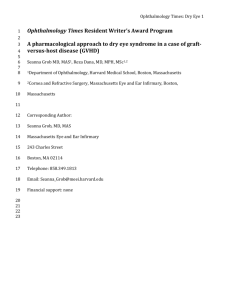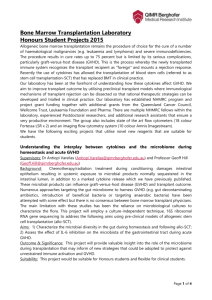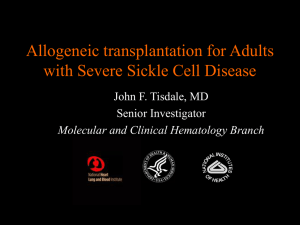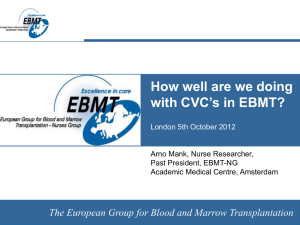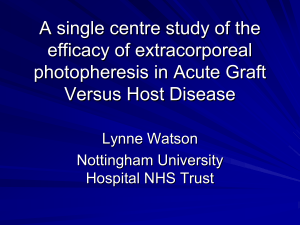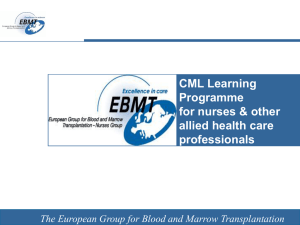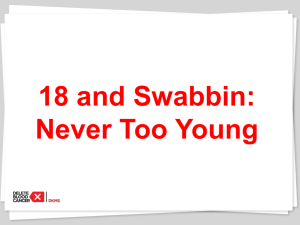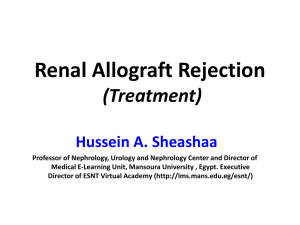The European Group for Blood and Marrow - Grrr-OH
advertisement
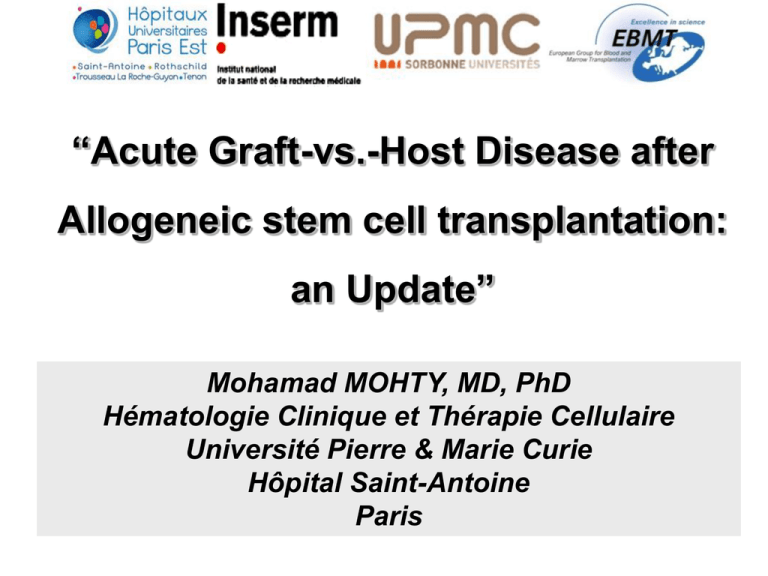
“Acute Graft-vs.-Host Disease after Allogeneic stem cell transplantation: an Update” Mohamad MOHTY, MD, PhD Hématologie Clinique et Thérapie Cellulaire Université Pierre & Marie Curie Hôpital Saint-Antoine Paris HSCT Activity in Europe 1990-2011: Transplant type 1st HSCT The European Group for Blood and Marrow Transplantation HSCT Activity in Europe 1990-2011: donor origin 1st HSCT The European Group for Blood and Marrow Transplantation Reduced Mortality after allo-HSCT over the past decade Gooley, TA. et al. N Engl J Med 2010;363:2091-101 Reduced NRM after allo-HSCT over the past 3 decades (Nantes Program) NRM 1983-1990 1991-2000 2001-2010 Years after transplantation Malard et al. Biol Blood Marrow Transplant 2014 HSCT Activity in Europe 2000-2011: MAC vs RIC 38% The European Group for Blood and Marrow Transplantation How to improve allo-SCT outcome? 1 Patient (age, gender, CMV, comorbidities…) 3 5 Conditioning Graft 6 Disease features -6 -5 -4 2 -3 -2 -1 4 0 Supportive Care and prevention of relapse +14 +21 +100 >180 GVHD prophylaxis and therapy The European Group for Blood and Marrow Transplantation The “GVL Effect” in Humans 20 yr ♂ with AML: 2 × 400 rad TBI plus marrow from 6 relatives A brother’s marrow engrafted Severe “secondary disease” † 20 months without leukemia ! Mathé et al., Br Med J, 1963 The European Group for Blood and Marrow Transplantation Acute GvHD • Inflammatory condition affecting one or more of the skin, gastrointestinal tract and liver, and occurring within 100 days of allogeneic transplantation • Later acknowledgement of similar syndrome occurring beyond day 100, known as late onset acute GvHD (particularly after RIC and DLI) • Affects 35-45% of recipients of HLA matched, and up to 60-80% of mismatched transplants • Affects approximately 40% of recipients of DLI but incidence rises with increasing cell dose The European Group for Blood and Marrow Transplantation Acute GvHD: Skin • >80% of cases of aGvHD • Macular papular rash affecting any part of the body, typically palmar & plantar erythema and sparing the scalp • Apoptosis at base of epidermal rete pegs • Dyskeratosis with adjacent satellite lymphocytes • perivascular lymphocytic infiltration in the dermis. The European Group for Blood and Marrow Transplantation Acute GvHD: GUT • Approximately 50% of cases • Nausea, vomiting and anorexia • Watery diarrhoea (typically green) and abdo cramps progressing to ileus and bloody diarrhoea • Endoscopy: patchy ulceration • CT scan: luminal dilatation with thickening of small bowel wall (ribbon sign), may have fluid levels • Pathology: apoptotic bodies in base of crypts, crypt abscesses, loss and flattening of surface epithelium The European Group for Blood and Marrow Transplantation Acute GvHD: Liver • Approximately 50% of cases • Cholestatic hyperbilirubinaemia • Difficult to distinguish from other causes of hepatic toxicity i.e. veno-occlusive disease, drugs, viral infections, sepsis, iron overload • Pathology: endothelialitis, lymphocytic infiltrate of portal areas, pericholangitis, bile duct destruction • Biopsy often not performed because of concurrent thrombocytopenia The European Group for Blood and Marrow Transplantation Acute GvHD: Staging stage skin Liver 1 <25% 34-50 Gut diarrhoea >500 ml 2 25-50% 51-102 >1000 3 >50% 103-255 >1500 4 Bullous disease >255 pain++ (bil:µmol/l) The European Group for Blood and Marrow Transplantation Acute GvHD: Grading grade skin liver gut I 1-2 0 0 5 year survival II 3, or 1, or 1 Grade III: 25% III 0-3 2-3, or 2-4 Grade IV: 5% IV 4, or 4 0-4 The European Group for Blood and Marrow Transplantation Acute GvHD: Pathophysiology First recognised in 1950s as ‘runt disease’ in mice Graft must contain immunologically competent cells Recipient must express tissue antigens not present in the donor Recipient incapable of monitoring an effective response to reject transplanted cells Billingham The European Group for Blood and Marrow Transplantation Acute GvHD: Pathophysiology Acute GvHD: Pathophysiology The European Group for Blood and Marrow Transplantation Acute GvHD: Risk Factors • • • • • • • Degree of HLA disparity Recipient age Conditioning regimen R/D gender combination Stem cell source Disease phase Viral infections The European Group for Blood and Marrow Transplantation Acute GvHD: Prevention and treatment Pharmacological Immunosuppression Corticosteroids Methotrexate Inhibition of cytoplasmic calcineurine Cyclosporine or Tacrolimus (FK506) Mycophenylate mofetil (MMF) Active compound, mycophenolic acid, Inhibits inosine monophosphate dehydrogenase (enzyme essential to de novo synthesis of guanosine nucleotides) and terminates DNA synthesis Sirolimus (binds to FKBP12) can be used in combination with FK506 The European Group for Blood and Marrow Transplantation Acute GvHD: Prevention and treatment Immunological and Cellular Antithymocyte globulin (ATG, ALG) Monoclonal antibodies CD20: rituximab CD52: alemtuzamab (Campath) CD2: alefacept (Blocks CD3-LFA3 interaction) CD3: OKT3, visilizumab TNF: infliximab, etanercept, adalimumab, certolizumab IL2/IL2R (CD25): dacluzamab, inolimomab, basiliximab, denileukin diftitox Extracorporeal photophoresis Cellular T-cell depletion Mesenchymal stem cells T-regulatory cells Suicide gene therapy of donor T-cells The European Group for Blood and Marrow Transplantation Acute GvHD: Prevention Gold standard is cyclosporine and methotrexate CsA/MTX and FK506/MTX better than CsA alone No benefit in adding corticosteroid FK506/MTX may be better than CsA/MTX The European Group for Blood and Marrow Transplantation Acute GvHD: Prevention Hoyt et al, BMT 2008 The European Group for Blood and Marrow Transplantation Evidence for immune control • Allogeneic BMT – GVHD / Relapse – T Cell depletion N 100 100 T Dep Non T Dep 57 35 Agvhd 5% 35 % Cgvhd 13 % 40 % DC de GVHD 7% 26 % Rejet 26 % 0% Rechute 47 % 17 % DFS 50 50 Non NonTdep Tdep TTDep Dep 00 00 11 22 33 44 55 66 77 88 Maraninchi et al., Lancet 1987 Acute GvHD: Prevention 70 60 % of patients 60 50 47 43 44 40 40 30 48 31 26 no ATG ATG 20 10 0 aGvHD II+ cGvHD survival 2 yy long term 6 yy 109 unrelated donor transplants BBMT 2006 12: 560 The European Group for Blood and Marrow Transplantation Acute GvHD: Unrelated transplants Parameter CsA-MTX-ATG % N=103 CsA-MTX % N-98 P value aGvHD > I 33 51 0.01 aGvHD > II 12 24.5 0.054 Any cGvHD 31 59 <0.0001 Ext CGvHD 12 43 <0.0001 100d TRM 11 13 NS 2yr TRM 20 29 NS 2yr relapse 29 24 NS 2yr DFS 52 48 NS Finke et al, Lancet Oncol 2009 The European Group for Blood and Marrow Transplantation Acute GvHD: Treatment Grade I skin disease may be controlled with topical steroids alone For GvHD > grade I, gold standard is corticosteroid 2mg/kg methylprednisolone Several studies show no benefit in increasing dose One study of steroid plus etanercept showed 70% resolution in one month Steroid refractory aGvHD ATG MoAbs MSC ECP Supportive care is critical ! The European Group for Blood and Marrow Transplantation Acute GvHD: Treatment Van Lint et al (GITMO) Blood 1998: 95 pts with > grade I aGvHD The European Group for Blood and Marrow Transplantation Acute GvHD: 2nd line treatment Treatment ATG Anti-IL2R Anti-TNF CsA to tacro Tacro + ATG MMF Pentostatin OKT3 Response 51% 40-70% 67% 10% 40% 50% 50% Survival 35% <30% 38% 35% 16% - 37% 26% 45% The European Group for Blood and Marrow Transplantation Acute GvHD: 3nd line treatment - MSC Le Blanc et al, Lancet 2008 The European Group for Blood and Marrow Transplantation Acute GvHD: what does the future hold? • Invariant NKT cells • Mesenchymal stromal cells • T-regulatory cells • Dendritic cells • Engineering specific anti-leukemic T-cells The European Group for Blood and Marrow Transplantation Immunosuppressive drugs and sites of action in the three-signal model Treg Methotrexate Adapted from Halloran P, N Engl J Med 2004 Immunosuppression: “the Promise of Specificity” T Cell TNF:TNF-R Super family CD28:B7 Super family APC CD83 LAT (linker for activation of T cells MERCI The European Group for Blood and Marrow Transplantation

